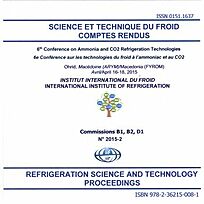
IIR document
Energetic analysis of CO2/propane and CO2/propylene cascade refrigeration system.
Number: pap. n. 43
Author(s) : KAIROUANI L., JEMNI N., NEHDI E.
Summary
Cascade systems using carbon dioxide, hydrocarbons and CO2/hydrocarbons mixture are studied. Theoretical models are written in FORTRAN. Thermodynamic parameters of fluids are given by REFPROP9.0 software. Working parameters (Te=-40C, Tc=40°C) are fixed. In the first step the most suitable hydrocarbons are selected. Three criteria have been fixed: Tcr, Tt and Tb. It is found that the hydrocarbons chosen in LPL are propane, propylene and ethane and those for the HPL are propane, propylene and isobutane. In the second step, xCO2 in the two loops has been varied and results are compared with cascade systems using CO2 and R22. Cascade system allows improved COP when pure fluids are used, except R22. It found also that for xCO2= 0.3 cascade system using propane/CO2 and propylene/CO2 mixtures presents a COP lower than that of cascade system using pure CO2. The higher COP is obtained when pure hydrocarbons are used in the two loops. COP=1.7, corresponds to propane (LPL)/isobutane (HPL) or propylene (LPL)/isobutane (HPL). An amelioration of the COP is observed when hydrocarbons are used in the HPL and CO2 in the LPL. COP=1.54, is reached when CO2 is used in LPL and isobutane is used in HPL. An improvement over the system using CO2 in the two loops, can reach 70%.
Available documents
Format PDF
Pages: 8 p.
Available
Public price
20 €
Member price*
15 €
* Best rate depending on membership category (see the detailed benefits of individual and corporate memberships).
Details
- Original title: Energetic analysis of CO2/propane and CO2/propylene cascade refrigeration system.
- Record ID : 30014669
- Languages: English
- Source: 6th Conference on Ammonia and CO2 Refrigeration Technology. Proceedings: Ohrid, North Macedonia, April 16-18, 2015.
- Publication date: 2015/04/16
Links
See other articles from the proceedings (53)
See the conference proceedings
Indexing
-
Themes:
Compression systems;
CO2;
Hydrocarbons - Keywords: Propylene; R744; Propane; Cascade system; Energy efficiency; Transcritical cycle; CO2
-
Análisis experimental de las mezclas de refrige...
- Author(s) : LARRONDO-SANCHO R., FALOMIR F. V., SÁNCHEZ D., CABELLO R.
- Date : 2024/06/26
- Languages : Spanish
- Source: 12th CYTEF Congress - Ibero-American Congress of Refrigeration Science and Technology.
- Formats : PDF
View record
-
Análisis y evaluación experimental de un sistem...
- Author(s) : ANDREU-NACHER A., CABELLO R., VIDAN-FALOMIR F., LARRONDO-SANCHO R., LLOPIS R., SÁNCHEZ D.
- Date : 2022/04
- Languages : Spanish
- Source: XI Congreso Ibérico y IX Congreso Iberoamericano de Ciencias y Técnicas del Frío, CYTEF 2022.
- Formats : PDF
View record
-
Le CO2 : pression écologique ou réalité énergét...
- Author(s) : GUILPART J.
- Date : 2013/10/10
- Languages : French
- Source: Pôle Cristal Symposium - 6th edition.
- Formats : PDF
View record
-
Prediction and comparison of CO2 subcritical an...
- Author(s) : WANG N. H.
- Date : 2002/08/26
- Languages : English
- Formats : PDF
View record
-
Optimization analysis on R290/CO2 cascade refri...
- Author(s) : LIU S., CHEN Y., NING J.
- Date : 2015/08/16
- Languages : English
- Source: Proceedings of the 24th IIR International Congress of Refrigeration: Yokohama, Japan, August 16-22, 2015.
- Formats : PDF
View record
